Cahokia
| Cahokia Mounds State Historic Site | |
|---|---|
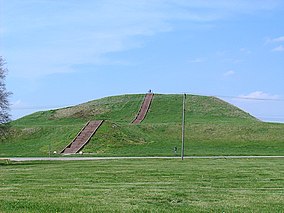 Monks Mound is the largest earthen structure at Cahokia | |
| Lua error in Module:Location_map at line 526: Unable to find the specified location map definition: "Module:Location map/data/USA relief" does not exist. | |
| Location | St. Clair County, Illinois, US |
| Nearest city | Collinsville, Illinois |
| Area | 2,200 acres (890 ha) |
| Governing body | Illinois Historic Preservation Agency |
| Official name | Cahokia Mounds State Historic Site |
| Type | Cultural |
| Criteria | iii, iv |
| Designated | 1982 (6th session) |
| Reference no. | 198 |
| State Party | |
| Region | Europe and North America |
| Official name | Cahokia Mounds |
| Designated | October 15, 1966[1] |
| Reference no. | 66000899 |
| Official name | Cahokia Mounds |
| Designated | July 19, 1964[1] |
Cahokia Mounds State Historic Site (/[invalid input: 'icon']kəˈhoʊkiə/) is located on the site of an ancient Native American city (c. 600–1400 CE) situated directly across the Mississippi River from modern St. Louis, Missouri. This historic park lies in Southern Illinois between East St. Louis and Collinsville.[2] The park, operated by the Illinois Historic Preservation Agency, is quite large, covering 2,200 acres (890 ha), or about 3.5 square miles, and containing about 80 mounds, but the ancient city was actually much larger. In its heyday, Cahokia covered about 6 square miles and included about 120 man-made earthen mounds in a wide range of sizes, shapes, and functions.[3]
Cahokia was the largest and most influential urban settlement in the Mississippian culture which developed advanced societies across much of what is now the Southeastern United States, beginning more than 500 years before European contact.[4] Cahokia's population at its peak in the 1200s was as large as, or larger than, any European city of that time, and its ancient population would not be surpassed by any city in the United States until about the year 1800. Today, Cahokia Mounds is considered the largest and most complex archaeological site north of the great Pre-Columbian cities in Mexico.
Cahokia Mounds is a National Historic Landmark and designated site for state protection. In addition, it is one of only 21 World Heritage Sites within the United States. It is the largest prehistoric earthen construction in the Americas north of Mexico.[3]
Designations
Cahokia Mounds was designated a National Historic Landmark on July 19, 1964, and listed on the National Register of Historic Places on October 15, 1966.[1]
In 1982 UNESCO (the United Nations Educational, Scientific and Cultural Organization) designated Cahokia Mounds State Historic Site as a World Heritage Site. The park protects 2,200 acres (890 ha), and is the center of continuing archaeological research. This is the only such site in Illinois and among only twenty-one World Heritage Sites in the United States.[5] United States Representative Evelyn M. Bowles wrote about the Cahokia Mounds site:
"Through the years my friends and I made occasional Sunday afternoon trips to the Mounds. When I became the State Senator, it afforded me the opportunity to secure funds for the acquisition of additional acreage in which there are smaller Mounds. Many of these have contained additional artifacts." The designation has helped protect the property and attract funds to conduct research on this significant civilization.[6]
History
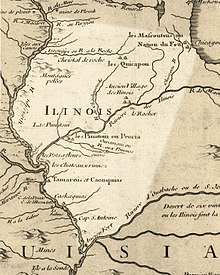
Although there is some evidence of Late Archaic period (approximately 1200 BCE) occupation in and around the site,[7] Cahokia as it is now defined was settled around 600 CE, during the Late Woodland period. Mound building at this location began with the Emergent Mississippian cultural period, about the 9th century CE.[8] The inhabitants left no written records beyond symbols on pottery, shell, copper, wood and stone, but the elaborately planned community, woodhenge, mounds and burials reveal a complex and sophisticated society.[9] The city's original name is unknown.
The original site contained 120 earthen mounds over an area of six square miles, of which 80 remain today. To achieve that, thousands of workers over decades moved more than an "estimated 55 million cubic feet of earth in woven baskets to create this network of mounds and community plazas. Monks Mound, for example, covers 14 acres (5.7 ha), rises 100 ft (30 m), and was topped by a massive 5,000 sq ft (460 m2) building another 50 ft (15 m) high."[3]
The Mounds were later named after a clan of historic Illiniwek people living in the area when the first French explorers arrived in the 17th century. As this was centuries after Cahokia was abandoned by its original inhabitants, the Cahokia were not necessarily descendants of the original Mississippian-era people. Scholars do not know which, if any Native American groups, are the living descendants of the people who originally built and lived at the Mound site, although many are plausible. Native American bands migrated through different areas, and those living in territories at the time of European encounter were often not the descendants of peoples who had lived there before.
Monks Mound
Monks Mound (pictured above, right) is the largest structure and central focus of the city: a massive platform mound with four terraces, 10 stories tall, and the largest man-made earthen mound north of Mexico. Facing south, it is 100 ft (30 m) high, 951 ft (290 m) long, 836 ft (255 m) wide and covers 13.8 acres (5.6 ha).[10] It also contains about 814,000 cu yd (622,000 m3) of earth.[11] The mound grew in stature over the course of several centuries through as many as ten separate construction episodes, as the mound was made ever higher and the terraces and apron were added.[10]
Monks Mounds received its name due to the community of Trappist monks that resided there for a short time, after Euroamericans settled the area. Excavation on the top of Monks Mound has revealed evidence of a large building, likely a temple or the residence of the paramount chief, which would have been seen throughout the city. This building was about 105 ft (32 m) long and 48 feet (15 m) wide, and could have been as much as 50 ft (15 m) high. It was about 5,000 sq ft (460 m2).
A large plaza located adjacent to Monks Mound was a place where games and public rituals took place. The most popular of the games was the game of Chunkey. The game was played with young men rolling a pill-shaped chunky stone across the field. The men would throw spears where they thought the chunky stone would land. The game required a great deal of judgement and aim.[11]
The east and northwest sides of Monks Mound were twice excavated in August 2007 during an attempt to avoid erosion due to slumping.[12]
Woodhenge

Archaeologists discovered postholes during excavation of the site to the west of Monks Mound, revealing a timber circle. Noting that the placement of posts marked solstices and equinoxes, they referred to it as "an American Woodhenge", likening it to England's well-known circles at Woodhenge and Stonehenge.[13][14] Detailed analytical work supports the hypothesis that the placement of these posts was by design.[15] The structure was rebuilt several times during the urban center's roughly 300-year history. Evidence of another timber circle was discovered near Mound 72, to the south of Monks Mound.
According to Chappell, "A beaker[16] found in a pit near the winter solstice post bore a circle and cross symbol that for many Native Americans symbolizes the Earth and the four cardinal directions. Radiating lines probably symbolized the sun, as they have in countless other civilizations."[17] The woodhenges were significant to the timing of the agricultural cycle.
Urban landscape
The Grand Plaza is a large open plaza that spreads out to the south of Monks Mound. Researchers originally thought the flat, open terrain in this area reflected Cahokia's location on the Mississippi's alluvial flood plain but instead soil studies have shown that the landscape was originally undulating. In one of the earliest large-scale construction projects, the site had been expertly and deliberately leveled and filled by the city's inhabitants. It is part of the sophisticated engineering displayed throughout the site. The Grand Plaza covered roughly 50 acres (20 ha) and measured over 1,600 ft (490 m) in length by over 900 ft (270 m) in width.[18] It was used for large ceremonies and gatherings, as well as for ritual games, such as chunkey. Along with the Grand Plaza to the south, three other very large plazas surround Monks Mound in the cardinal directions to the east, west, and north.
The high-status district of Cahokia was surrounded by a long palisade that was equipped with protective bastions. Where the palisade passed, it separated neighborhoods.[11] Archaeologists found evidence of the stockade during excavation of the area and indications that it was rebuilt several times. Its bastions showed that it was mainly built for defensive purposes.[11]
Beyond Monks Mound, as many as 120 more mounds stood at varying distances from the city center. To date, 109 mounds have been located, 68 of which are in the park area. The mounds are divided into several different types: platform, conical, ridge-top, etc.. Each appeared to have had its own meaning and function. In general terms, the city center seems to have been laid out in a diamond-shaped pattern approximately 1 mi (1.6 km) from end to end, while the entire city is 5 mi (8.0 km) across from east to west.
Ancient city
Cahokia was the most important center for the peoples known today as Mississippians. Their settlements ranged across what is now the Midwest, Eastern, and Southeastern United States. Cahokia was located in a strategic position near the confluence of the Mississippi, Missouri and Illinois rivers. It maintained trade links with communities as far away as the Great Lakes to the north and the Gulf Coast to the south, trading in such exotic items as copper, Mill Creek chert,[19] and whelk shells. Mill Creek chert, most notably, was used in the production of hoes, a high demand tool for farmers around Cahokia and other Mississippian centers. Cahokia's control of the manufacture and distribution of these hand tools was an important economic activity that allowed the city to thrive.[11] Mississippian culture pottery and stone tools in the Cahokian style were found at the Silvernale site near Red Wing, Minnesota, and materials and trade goods from Pennsylvania, the Gulf Coast and Lake Superior have been excavated at Cahokia.
At the high point of its development, Cahokia was the largest urban center north of the great Mesoamerican cities in Mexico. Although it was home to only about 1,000 people before c. 1050, its population grew explosively after that date. Archaeologists estimate the city's population at between 6,000 and 40,000 at its peak, with more people living in outlying farming villages that supplied the main urban center. In 1250, its population was about 15,000, comparable to that of London or Paris during the same period.[20]
If the highest population estimates are correct, Cahokia was larger than any subsequent city in the United States until the 1780s, when Philadelphia's population grew beyond 40,000.[21]
One of the major problems that large centers like Cahokia faced was keeping a steady supply of food, and waste disposal was also an issue, which made Cahokia an unhealthy place. Being that it was such an unhealthy place to live in, the town had to rely on social and political attractions to bring in a steady supply of new immigrants, otherwise the town's death rate would have left it abandoned earlier.[11]
Mound 72

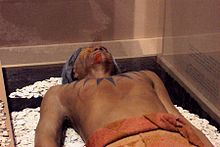
During excavation of Mound 72, a ridge-top burial mound south of Monks Mound, archaeologists found the remains of a man in his 40s who was probably an important Cahokian ruler. The man was buried on a bed of more than 20,000 marine-shell disc beads arranged in the shape of a falcon,[22] with the bird's head appearing beneath and beside the man's head, and its wings and tail beneath his arms and legs. The falcon warrior or "birdman" is a common motif in Mississippian culture. This burial clearly had powerful iconographic significance. In addition, a cache of sophisticated, finely worked arrowheads in a variety of different styles and materials was found near the grave of this important man. Separated into four types, each from a different geographical region, the arrowheads demonstrated Cahokia's extensive trade links in North America.
Archeologists recovered more than 250 other skeletons from Mound 72. Scholars believe almost 62 percent of these were sacrificial victims, based on signs of ritual execution, method of burial, and other factors.[23] The skeletons include:
- Four young males, missing their hands and skulls.
- A mass grave of more than 50 women around 21 years old, with the bodies arranged in two layers separated by matting.
- A mass burial containing 40 men and women who appear to have been violently killed. The suggestion has been made that some of these were buried alive: "From the vertical position of some of the fingers, which appear to have been digging in the sand, it is apparent that not all of the victims were dead when they were interred – that some had been trying to pull themselves out of the mass of bodies."[24]
The relationship of these burials to the central burial is unclear. It is unlikely that they were all deposited at the same time. Wood in several parts of the mound has been radiocarbon-dated to between 950 and 1000 CE.
Excavations have indicated that Mound 72 was not constructed as a single mound, but rather as a series of smaller mounds. These mounds were reshaped and covered over to give Mound 72 its final ridge-top shape.[25]
Copper workshop
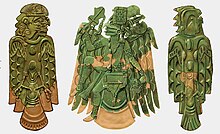
Excavations near Mound 34 from 2002 to 2010 have revealed a copper workshop, although the one of a kind discovery had been previously found in the 1950s by archaeologist Greg Perino but lost for 60 years. It is the only known copper workshop to be found at a Mississippian site.[26] The area contains the remains of three tree stumps thought to have been used to hold anvil stones. Analysis of copper found during excavations showed that it had been annealed, a technique involving repeatedly heating and cooling the metal as it is worked, such as blacksmiths do with iron.[26] Artisans worked here to produce religious items, such as long-nosed god maskettes, ceremonial earrings with a symbolic shape, thought to have been used in fictive kinship rituals.[27][28] Many of the stylistically related Mississippian copper plates such as the Wulfing cache from southeastern Missouri, some of the Etowah plates from Georgia, and many of the Spiro plates from Oklahoma are associated with the Greater Braden Style and are thought to have been made in Cahokia in the 13th century.[29][30][31][32]
Cahokia's decline

Cahokia began to decline after 1300 CE. It was abandoned more than a century before Europeans arrived in North America, in the early 16th century,[33] and the area around it was largely uninhabited by indigenous tribes.[34] Scholars have proposed environmental factors, such as over-hunting and deforestation as explanations. The houses, stockade, and residential and industrial fires would have required the annual harvesting of thousands of logs. In addition, climate change could have aggravated effects of erosion due to deforestation, and adversely affected the cultivation of maize, on which the community had depended.
Another possible cause is invasion by outside peoples, though the only evidence of warfare found so far is the wooden stockade and watchtowers that enclosed Cahokia's main ceremonial precinct. Due to the lack of other evidence for warfare, the palisade appears to have been more for ritual or formal separation than for military purposes. Diseases transmitted among the large, dense urban population are another possible cause of decline. Many recent theories propose conquest-induced political collapse as the primary reason for Cahokia’s abandonment.[35]
Related Mounds

Until the 19th century a series of similar mounds existed in what is now the city of St. Louis, some 20 km (12 mi) to the south west of the Cahokia site. Most of these mounds were levelled during the construction of St. Louis, as their material was reused in construction projects.
The lone survivor of these mounds is the Sugarloaf Mound, which is located on the west bank of the Mississippi, on the former border between St. Louis and the autonomous city of Carondelet.
The Cahokia Museum and Interpretive Center
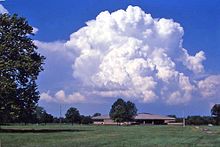
The Cahokia Museum and Interpretive Center, which receives up to a million visitors a year, was designed by AAIC Inc. The building which opened in 1989 received the Thomas H. Madigan Award, the St. Louis Construction News & Reviews Readers Choice Award, the Merit Award from the Metal Construction Association and the Outstanding Achievement Award from the Brick Manufacturer Association.
See also
- American Bottom
- Chunkey
- List of archaeoastronomical sites sorted by country
- List of Mississippian sites
- Mississippian culture
- Mississippian stone statuary
- Southeastern Ceremonial Complex
- World Heritage Site
References
- ^ a b c "Cahokia Mounds". National Historic Landmark summary listing. National Park Service. Retrieved July 23, 2008.
- ^ Cahokia Mounds Homepage; Map of the Site
- ^ a b c "Nomination – Cahokia Mounds State Historic Site, Illinois", US World Heritage Sites, National Park Service, accessed 2012-05-03
- ^ Sacredland.org "Mississippian Mounds", Sacred Land Film Project
- ^ "United States of America – UNESCO World Heritage Centre". UNESCO World Heritage Centre. March 11, 2009. Retrieved March 11, 2009.
- ^ "Congressional representative letter". Cahokia Mounds State Historic Site. Retrieved October 30, 2011.
- ^ James M. Collins, The archaeology of the Cahokia Mounds ICT-II, Springfield IL, Illinois Historic Preservation Agency (1990) ISBN 0-942579-10-0
- ^ Emerson, Thomas E., Lewis, R. Barry Cahokia and the Hinterlands: Middle Mississippian Cultures of the Midwest University of Illinois Press; New edition (Jun 30, 2000) ISBN 978-0-252-06878-2 pp.33 & 46
- ^ Townsend, Richard F; Sharp, Robert V; Bailey, Garrick Alan (2000). Hero, Hawk, and Open Hand: American Indian Art of the Ancient Midwest and South. Yale University Press. ISBN 0-300-10601-7.
- ^ a b Skele, Mike (1988). "The Great Knob". Studies in Illinois Archaeology (4). Springfield, Illinois: Illinois Historic Preservation Agency. ISBN 0-942579-03-8.
- ^ a b c d e f Snow, Dean (2010). Archaeology of Native North Americas. Upper Saddle River, NJ: Prentice Hall. pp. 201–203.
- ^ "Monks Mound Slump Repair, Page 1". Lithiccastinglab.com. July 31, 2007. Retrieved September 10, 2012.
- ^ Wittry, Warren L., "An American Woodhenge," Cranbrook Institute of Science Newsletter, Vol. 33(9), pages 102–107, 1964; reprinted in Explorations into Cahokia Archaeology, Bulletin 7, Illinois Archaeological Survey, 1969.
- ^ Wittry, Warren L. "Discovering and Interpreting the Cahokia Woodhenges", The Wisconsin Archaeologist, Vol. 77(3/4), pages 26–35.
- ^ Friedlander, Michael W., "The Cahokia Sun Circles", The Wisconsin Archeologist, Vol. 88(1), pages 78–90, 2007.
- ^ "Art Archives:pxartxx7clr2.jpg". Museum.state.il.us. Retrieved September 10, 2012.
- ^ Chappell, Sally Anderson (2002) Cahokia: Mirror of the Cosmos. University of Chicago Press. ISBN 0-226-10137-1. Page 100.
- ^ Timothy R., Pauketat (2009). Cahokia : Ancient Americas Great City on the Mississippi. Viking Press. pp. 23–34. ISBN 978-0-670-02090-4.
Pg 23 "Cahokia was so large-covering three to five square miles-that archaeologists have yet to probe many portions of it. Its centerpiece was an open fifty-acre Grand Plaza, surrounded by packed-clay pyramids. The size of thirty-five football fields, the Grand Plaza was at the time the biggest public space ever conceived and executed north of Mexico."...Pg 34 "a flat public square 1,600-plus feet in length and 900-plus feet in width
- ^ "Illinois Agriculture-Technology-Hand tools-Native American Tools". Retrieved July 12, 2010.
- ^ Lowery, Malinda Maynor. "Civilization is All Relative". Teachinghistory.org. Retrieved June 30, 2011.
- ^ United States Census Office, A Century of Population Growth from the First Census of the United States to the Twelfth: 1790–1900, Government Printing Office, 1909, p. 11
- ^ "Cahokia and the excavation of Mound 72". Retrieved August 21, 2010.
- ^ Young & Fowler, p. 148.
- ^ Young & Fowler, pp. 146–149.
- ^ "Mound 72". Cahokia Mounds State Historic Site. Retrieved March 31, 2012.
- ^ a b Pawlaczyk, George (February 16, 2010), Copper men: Archaeologists uncover Stone Age copper workshop near Monks Mound., retrieved November 8, 2010
- ^ "Gahagan Long-nosed god maskette". University of Texas at Austin. Retrieved July 30, 2010.
- ^ "Aztalan – Wisconsin's Middle Mississippian Outpost". Milwaukee Public Museum. Retrieved July 30, 2010.
- ^ Kelly, John E.; Brown, James A.; Hamlin, Jenn M.; Kelly, Lucretia S.; Kozuch, Laura; Parker, Kathryn; Van Nest, Julieann. "Mound 34 : The Context for the Early Evidence of the Southeastern Ceremonial Complex at Cahokia". In King, Adam (ed.). Southeastern Ceremonial Complex : Chronology, Content, Context. University of Alabama Press. pp. 57–87. ISBN 978-0-8173-5409-1.
- ^ Robb, Matthew H. (March 2010). "Mildred Lane Kemper Art Museum-Spotlight Series March 2010" (PDF). Saint Louis Art Museum. Retrieved May 2, 2012.
- ^ King, Adam (2004). "Power and the Sacred : Mound C and the Etowah Chiefdom". In Townsend, Richard F.; Sharp, Robert V. (eds.). Hero, Hawk, and Open Hand : American Indian Art of the Anicent Midwest and South. New Haven: Yale University Press. p. 151. ISBN 0-300-10601-7.
- ^ Bolfing, Christopher (May 1, 2010). The Paradigm of the Periphery in Native North America (Thesis). Texas State University-San Marcos, University College, University Honors Program. pp. 67–68. Retrieved May 2, 2012.
- ^ Young & Fowler p.301
- ^ Pyburn, K. Anne, Ungendering Civilization Routledge; 1 edition (Jan 29, 2004) ISBN 978-0-415-26058-9 [1]
- ^ Emerson 1997, Pauketat 1994.
Further reading
- Introductory Bibliography of Published Sources on Cahokia Archeology
- Scholarly Bibliography of Published Sources on Cahokia Archaeology
- Chappell, Sally A. Kitt (2002). Cahokia: Mirror of the Cosmos. Chicago: University of Chicago Press. ISBN 978-0-226-10136-1.
- Emerson, Thomas E. (1997). Cahokia and the Archaeology of Power. Tuscaloosa, AL: University of Alabama. ISBN 0-8173-0888-1.
- Emerson, Iseminger (2001). Cahokia Mounds State Historical Site Nature/Culture Hike Guidebook, 4th revised edition. Collinsville, Illinois: Cahokia Mounds Museum Society. pp. 79 pp.
{{cite book}}: Unknown parameter|coauthors=ignored (|author=suggested) (help) - Emerson, Thomas E.; Lewis, R. Barry (1991). Cahokia and the Hinterlands: Middle Mississippian Cultures of the Midwest. Urbana, Illinois: University of Illinois. ISBN 0-252-06878-5.
- Fowler, Melvin L.; Rose, Jerome; Leest, Barbara Vander; Ahler, Steven R. (1999). The Mound 72 Area: Dedicated and Sacred Space in Early Cahokia. Illinois State Museum Society. ISBN 978-0-89792-157-2.
- Milner, George R. (2004). The Moundbuilders: Ancient Peoples of Eastern North America. London: Thames and Hudson, Ltd.
- Mink, Claudia Gellman (1992). Cahokia, City of the Sun: Prehistoric Urban Center in the American Bottom. Collinsville, IL: Cahokia Mounds Museum Society. ISBN 1-881563-00-6.
- Pauketat, Timothy (1994). The Ascent of Chiefs: Cahokia and Mississippian Politics in Native North America. Tuscaloosa, AL: University of Alabama. ISBN 0-8173-0728-1.
- Pauketat, Timothy R. (2009). Cahokia: Ancient America's Great City on the Mississippi. New York: Viking Adult. ISBN 978-0-670-02090-4.
- Price, Douglas T.; Feinman, Gary M. (2008). Images of the Past (5 ed.). New York: McGraw-Hill. pp. 280–285. ISBN 978-0-07-340520-9.
- Young, Biloine; Fowler, Melvin L. (2000). Cahokia: The Great Native American Metropolis. Urbana, Illinois: University of Illinois. ISBN 0-252-06821-1. full text available at [2]
External links
- Cahokia Mounds Homepage and Map of the Site
- "Cahokia Mounds State Historic Site, Illinois", World Heritage Site, National Park Service
- "Cahokia Mounds", Illinois Historic Preservation Agency
- "Metropolitan Life on the Mississippi", Washington Post, March 12, 1997
- Mississippian Art and Artifacts
- Visitors' perspectives
- Woodhenge and the Cahokia Mounds
- "Cahokia: America’s Lost City", National Geographic Magazine, January 2011
- 8-minute video on Cahokia, including excellent animation segments
 Cahokia travel guide from Wikivoyage
Cahokia travel guide from Wikivoyage
- Ill-formatted IPAc-en transclusions
- Middle Mississippian culture
- Mounds in the United States
- Native American history of Illinois
- Native American museums in Illinois
- Archaeological museums in Illinois
- Museums in St. Clair County, Illinois
- Illinois state parks
- Archaeological sites in Illinois
- Native American archeology
- Former Native American populated places in the United States
- Populated places established in the 7th century
- National Register of Historic Places in St. Clair County, Illinois
- National Historic Landmarks in Illinois
- World Heritage Sites in the United States
- Protected areas of St. Clair County, Illinois
- Pre-historic cities in the United States

